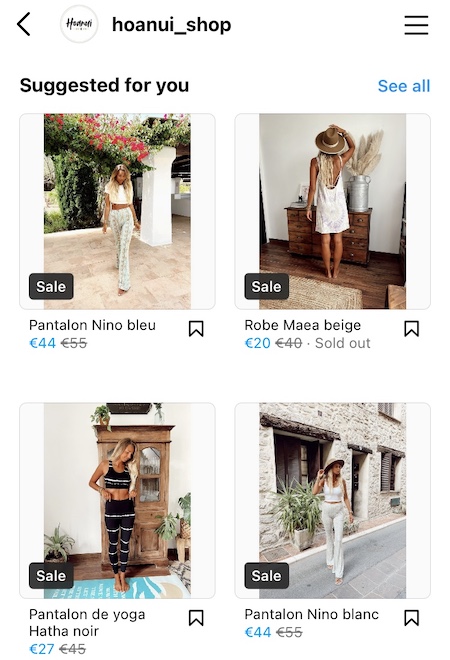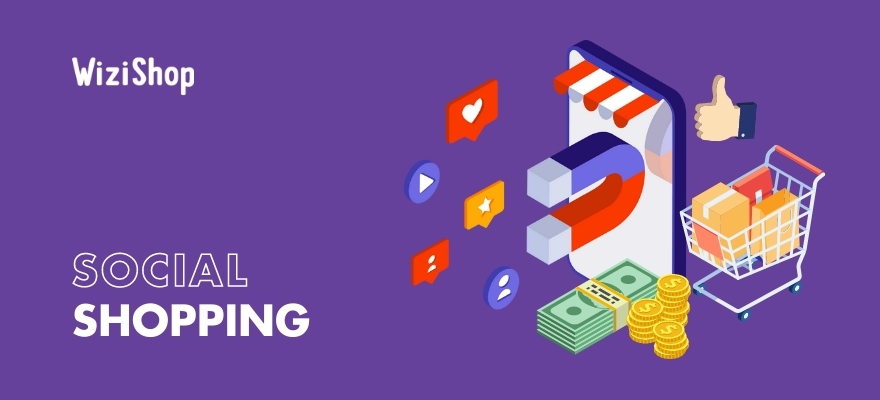Who’s never searched what was said about a product or a company on the internet before buying? Who’s never come across a product or service offer directly on their social networking pages?
Commerce is becoming increasingly social. Before, during, or after the purchase, no matter where, more and more consumers have access to the internet and social media to get information and to buy.
With social applications, social networks, and sharing platforms, it’s now easy to get consumer feedback or see the great deals shared by both internet users and brands. Consumers are buying based on recommendations and their immediate favorites.
What are the stakes of social shopping and how to succeed in its marketing strategy?
What is social shopping?
Interactions between different sales channels are multiplying with the rise of internet and mobile technologies (mobile applications, geolocation, augmented reality, kiosks, etc.) that promote nomadism and interconnections. Moreover, m-commerce, or mobile commerce, is exploding!
We’re talking about connected commerce. It’s a type of commerce seen in its globality, where the border between traditional commerce and ecommerce tends to disappear. As for social shopping, it’s the concept meaning the dialogue and the synergy between users regarding the purchase of products or services via the internet.
It’s integrated in this increasingly connected commerce to take advantage not only of technology but especially of users.
Definition and benefits
Social media is omnipresent and is changing the way we consume. Social commerce is particularly highlighting this ecommerce trend. As the role of social media in ecommerce continues to grow, it’s now possible for an e-merchant to sell their products directly from their social networks. You allow “your” community to exchange and buy within the same tool.
With Facebook, observers have evoked the notion of the web within the web. That is to say a kind of web within the web in which internet users can find all the information about a brand, the opinions of their community, but also make their purchases without leaving the social network.
Internet users could almost do without the web outside the limits of the platforms. However, it’s important to remember that social commerce differs from ecommerce. Social shopping doesn’t replace the brands’ ecommerce sites; it’s instead an additional gateway to the heart of the community.
Social shopping was originally the notion defining the influence of the Internet and social networks on the act of online shopping by users around the world. Before ecommerce arrived on social platforms and at the beginning of social media, online shopping facilities were feeble, but the influence of the different communities and user generated content (opinions, notes, comments) was already present.
Brands were present on Instagram, Facebook, and Pinterest, and they were the subject of community shopping, online shopping impacted by the various discussions between subscribers or fans of blogs and forums, influencers of the time. This modern word-of-mouth shopping made its debut before various technological devices came into being, such as the “Shopping” function now integrated into most social networks.
Today, it’s possible to have a shopping experience without leaving one’s app or social media, which has become a sales channel in its own right, social shopping for an omnichannel sales strategy.
From sales sites to social networks: the challenges of social shopping
- Community-based social shopping
The influence of the community has always been important on the buying act of users. The main change lies in the fact that a community is growing, connecting massively and that the tools that are the basis of it are intensifying. Internet users consult reviews: 91% of them even say they are influenced first and foremost by reviews in their purchase decision.
Instagram for ecommerce, for example, would be conducive to the dissemination of information on new products and dialogue with existing customers.
YouTube allows you to go further in the presentation of your products with video and allows you to receive comments and even to make your offer more viral, just like on Instagram via IGTV, reels, or stories.
Pinterest makes it possible for you to sublimate your brand image while proposing trendy contents, while TikTok will allow you to put forward your content in a massive way by choosing the right levers (hashtags, music, etc.).
Review sites such as Tripadvisor are multiplying and allow you to collect visible feedback on customer experiences. Internet users are fond of all these platforms before and after their purchases.
Other sites have slipped into the breach and offer alternative sharing services, such as the 21 buttons application: you create a social profile, a sort of Instagram dedicated to clothes and accessories with the possibility of tagging partner brands to directly access the reference of the product worn by the user. If we like a photo, a second click takes us to the brand’s shopping site.

Finally, the trend is increasingly heading toward gamification, i.e., rewarding your best customers and followers in the form of a contest by creating a competition around a post for them to win products and services or exclusive promotional offers. Everything is in fact based on the sine qua non condition of the existence or creation of a community and the interaction between its members, i.e., the creation of content or sharing on social media.
- Social shopping to conquer ecommerce
Social shopping (or social commerce) is also defined in a new way since the arrival of advanced features for brands on apps and platforms.
On Instagram, Facebook, Pinterest, Snapchat, and TikTok, it’s possible to buy items and services without having to leave one’s app. By directly integrating payment solutions and commerce interfaces, these applications are evolving ecommerce to allow brands to claim additional revenue by converting their network visitors directly into customers.
The opportunity is also given to new brands to start selling online and test their products before subscribing to a powerful ecommerce solution like WiziShop.
Try WiziShop free for 7 days
THE EASIEST NO-CODE ECOMMERCE SOLUTION✅ No credit card required
✅ Access to all features
✅ No commitment
Facebook, Instagram, Pinterest... Social shopping trends
The top platforms and apps in social shopping
- Facebook Shops
The top of the podium of all networks is Facebook. According to a survey of social networks conducted by E-Commerce Nation, 91% of the top e-tailers have a Facebook page.
Beyond ensuring a presence on the network, Facebook has launched “Facebook Shops,” a free feature reserved for all creators and merchants wishing to create a virtual store to sell and collect their revenue via the platform.
You’ll also be able to offer your items for sale in advanced advertisements, to reach new customers.
- Instagram Shopping
Since 2018, Instagram has invested in the field of online sales by introducing its “Shopping” tab to have access to products sold by merchants directly on the application.
According to Digimind, 1 billion users are active every month, and 90% of Instagram users follow brands. Instagram is also a decision-making accelerator, as 80% of users use the app before a purchase.
Thanks to the Shopping function, users have integrated this new way of consuming for 130 million of them who click on at least one purchase ad every day.
More than a need, it’s a real necessity to launch on Instagram Shopping by linking your ecommerce WiziShop store, like Hoanui, which offers its entire catalog directly on Instagram.

Pinterest offers the most comprehensive shopping service of any social platform. Thanks to its inspirational model, it drives a lot of traffic to online shopping sites, in addition to ensuring great retention…so many chances to convert your audience into customers!
In addition, it allows users to create inspiration boards and create looks directly on the application. All features have been optimized for stores and designers who want to sell on Pinterest Shopping.

Steps and tips for a successful social shopping strategy
Your ability to take full advantage of social commerce depends greatly on your e-reputation. That's why it’s crucial to interact with your customers, to identify influencers. Try to turn your regular customers into ambassadors by giving them appropriate information, such as the exclusivity or the first opportunity to discover your latest product and to announce its launch together.
In addition, propose special offers, which are very popular with people who follow a brand on a social network. Don’t neglect the negative feedback from your customers, especially since they might share it with 11 people around them if you don’t satisfy them.
When using social media for ecommerce, consider that each social media platform has its own particularities, dialogue in a differentiated way according to the members and according to the reference brands. You don’t talk to your followers on Snapchat the same way you talk to your fans on Facebook. Bloggers won’t be interested in your daily news—contact them when you really have something new. All this community management should really be part of a more global strategy.
Going from conversations to conversions by multiplying the points of contact takes a lot of time, but this is the price companies pay to adapt to their customers’ new practices. It means keeping an eye on your e-reputation. It’s about encouraging dialogue with your community by making them want to buy your products. You have to find the right tone, adapt your discourse to avoid sounding too commercial. It’s necessary to create engagement, i.e., the involvement of internet users. This is to establish a more personalized customer relationship to improve satisfaction.
Including the “social” element in the sale of your products really helps to increase customer loyalty and to acquire new customers. Social commerce offers new opportunities. Marketing targets are sub-segmenting into communities with homogeneous interests and practices.
The means to reach them are more numerous and more precise. Companies, especially smaller ones, still underestimate the business potential. However, studies show that so-called “social” brands sell more than others. The major risk is not to control your image with “social shoppers.” A communication agency can help you in your social shopping experience!










